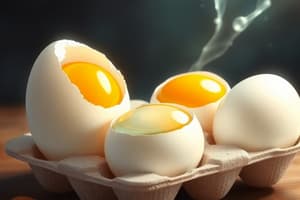Podcast
Questions and Answers
Which of the following is NOT a monosaccharide?
Which of the following is NOT a monosaccharide?
- Maltose (correct)
- Galactose
- Fructose
- Glucose
Starch is a complex carbohydrate that serves as a source of fiber and can be found in foods like potatoes and rice.
Starch is a complex carbohydrate that serves as a source of fiber and can be found in foods like potatoes and rice.
True (A)
What is the name of the reaction that occurs when sugar and amino acids are heated together, resulting in the characteristic color, flavor, and aroma of baked goods?
What is the name of the reaction that occurs when sugar and amino acids are heated together, resulting in the characteristic color, flavor, and aroma of baked goods?
Maillard reaction
Glucose and ______ combine to form the disaccharide lactose.
Glucose and ______ combine to form the disaccharide lactose.
Match the following terms with their correct definitions.
Match the following terms with their correct definitions.
What are the four most common molecules found in food?
What are the four most common molecules found in food?
The proximate composition of food refers to the exact molecular makeup of each nutrient.
The proximate composition of food refers to the exact molecular makeup of each nutrient.
What is the primary difference between wet basis and dry basis calculations in food composition?
What is the primary difference between wet basis and dry basis calculations in food composition?
A food with a high ______ content is more likely to be perishable.
A food with a high ______ content is more likely to be perishable.
Which of these is NOT a primary function of carbohydrates in food?
Which of these is NOT a primary function of carbohydrates in food?
The energy value of a food is primarily determined by its carbohydrate content.
The energy value of a food is primarily determined by its carbohydrate content.
Match each macronutrient with its corresponding energy value per gram:
Match each macronutrient with its corresponding energy value per gram:
Explain the significance of understanding food composition in relation to food preservation.
Explain the significance of understanding food composition in relation to food preservation.
What is the primary method used to determine the proximate composition of food?
What is the primary method used to determine the proximate composition of food?
The structure of carbohydrates is always linear, never in a ring form.
The structure of carbohydrates is always linear, never in a ring form.
Which of the following is NOT a function of lipids in food?
Which of the following is NOT a function of lipids in food?
Fats are solid at room temperature and are made up of unsaturated fatty acids.
Fats are solid at room temperature and are made up of unsaturated fatty acids.
What happens to fats during oxidative rancidity?
What happens to fats during oxidative rancidity?
The process of removing or reducing water from food products is the primary way to ______ and/or preserve them.
The process of removing or reducing water from food products is the primary way to ______ and/or preserve them.
Which of the following methods can be used to preserve food by reducing water content?
Which of the following methods can be used to preserve food by reducing water content?
Free water is easily extracted from food by squeezing, cutting, or pressing.
Free water is easily extracted from food by squeezing, cutting, or pressing.
Match the following water types in food with their respective characteristics:
Match the following water types in food with their respective characteristics:
What does the term 'water activity' (aw) describe in food?
What does the term 'water activity' (aw) describe in food?
Which of the following is NOT a function of water in food?
Which of the following is NOT a function of water in food?
Micronutrients are always found in their optimal levels in processed foods.
Micronutrients are always found in their optimal levels in processed foods.
Minerals in food are represented as ______ after the organic components are removed.
Minerals in food are represented as ______ after the organic components are removed.
Trace minerals like iron, zinc, and iodine are considered macrominerals.
Trace minerals like iron, zinc, and iodine are considered macrominerals.
What is the primary function of vitamins in the body?
What is the primary function of vitamins in the body?
Which of the following is an example of a macromineral?
Which of the following is an example of a macromineral?
Fortification is the process of adding micronutrients to processed foods to increase their nutritional value.
Fortification is the process of adding micronutrients to processed foods to increase their nutritional value.
Which of the following is NOT a primary function of starch, cellulose, pectin, and gums in food?
Which of the following is NOT a primary function of starch, cellulose, pectin, and gums in food?
Amylose is the branched chain component of starch, responsible for its thickening properties.
Amylose is the branched chain component of starch, responsible for its thickening properties.
What is the primary structural difference between amylose and amylopectin?
What is the primary structural difference between amylose and amylopectin?
The process of hydrolyzing proteins involves breaking down the long chains of ______ into individual amino acids.
The process of hydrolyzing proteins involves breaking down the long chains of ______ into individual amino acids.
Match the protein structures with their corresponding descriptions:
Match the protein structures with their corresponding descriptions:
Which of the following factors can cause protein denaturation?
Which of the following factors can cause protein denaturation?
What is the role of egg yolk in food?
What is the role of egg yolk in food?
Proteins precipitate at the isoelectric point, where the pH has a net charge on the protein.
Proteins precipitate at the isoelectric point, where the pH has a net charge on the protein.
High fructose corn syrup is produced by isomerizing ______ molecules into fructose.
High fructose corn syrup is produced by isomerizing ______ molecules into fructose.
What is the primary advantage of high fructose corn syrup over other sweeteners?
What is the primary advantage of high fructose corn syrup over other sweeteners?
Flashcards
Starch
Starch
A carbohydrate that serves as a source of fiber and energy.
Browning Reactions
Browning Reactions
Chemical reactions that produce color and flavor, like caramelization and Maillard reaction.
Caramelization
Caramelization
Decomposition of sugar under heat, resulting in brown polymers.
Oligosaccharides
Oligosaccharides
Signup and view all the flashcards
Polysaccharides
Polysaccharides
Signup and view all the flashcards
Amylose
Amylose
Signup and view all the flashcards
Amylopectin
Amylopectin
Signup and view all the flashcards
Cellulose
Cellulose
Signup and view all the flashcards
Pectin
Pectin
Signup and view all the flashcards
Proteins
Proteins
Signup and view all the flashcards
Primary structure
Primary structure
Signup and view all the flashcards
Isoelectric point
Isoelectric point
Signup and view all the flashcards
Denaturation
Denaturation
Signup and view all the flashcards
Emulsifier
Emulsifier
Signup and view all the flashcards
Food Composition
Food Composition
Signup and view all the flashcards
Proximate Composition
Proximate Composition
Signup and view all the flashcards
Wet Basis Calculation
Wet Basis Calculation
Signup and view all the flashcards
Dry Basis Calculation
Dry Basis Calculation
Signup and view all the flashcards
Energy Value of Carbs
Energy Value of Carbs
Signup and view all the flashcards
Energy Value of Proteins
Energy Value of Proteins
Signup and view all the flashcards
Energy Value of Fats
Energy Value of Fats
Signup and view all the flashcards
Energy Value of Alcohol
Energy Value of Alcohol
Signup and view all the flashcards
Key Macromolecules
Key Macromolecules
Signup and view all the flashcards
Carbohydrates Function
Carbohydrates Function
Signup and view all the flashcards
Casein
Casein
Signup and view all the flashcards
Lipids
Lipids
Signup and view all the flashcards
Triglycerides
Triglycerides
Signup and view all the flashcards
Essential fatty acids
Essential fatty acids
Signup and view all the flashcards
Hydrolytic rancidity
Hydrolytic rancidity
Signup and view all the flashcards
Oxidative rancidity
Oxidative rancidity
Signup and view all the flashcards
Water activity (aw)
Water activity (aw)
Signup and view all the flashcards
Free water
Free water
Signup and view all the flashcards
Bound water
Bound water
Signup and view all the flashcards
Macrominerals
Macrominerals
Signup and view all the flashcards
Trace minerals
Trace minerals
Signup and view all the flashcards
Micronutrients
Micronutrients
Signup and view all the flashcards
Vitamin degradation
Vitamin degradation
Signup and view all the flashcards
Study Notes
Food Composition
- Food products originate from agricultural systems, progressing from farms to consumers.
- Food is composed of plant and animal cells.
- Food is primarily composed of carbohydrates, proteins, water, fat, and vitamins/minerals.
- The proportions and properties of these components influence food characteristics.
- Food composition guides preservation and processing techniques.
Common Food Molecules
- Common molecules include carbon, hydrogen, oxygen, and nitrogen.
- Other ions like calcium (Ca), iron (Fe), sodium (Na), and chlorine (Cl) are present.
- Carbohydrates, lipids, minerals, proteins, water, and vitamins collectively describe food composition.
Proximate Composition
- Proximate composition estimates nutritional composition.
- Components add up to 100%.
- Categorized, not specific molecules for easier determination of storage and shelf life.
Food Composition Examples
- Cooked turkey breast has a high water content, making it easily perishable.
Calculating Proximate Analysis
- Wet basis analysis considers the water content within a food sample.
- Dry basis analysis excludes water content, facilitating comparisons.
- Dry basis is common, particularly in nutrition tables.
Analytical Methods for Food Components
- Water: Determined by weight loss through drying.
- Protein: Measured using the Kjeldahl method, involving sulfuric acid digestion and converting nitrogen to protein.
- Lipids: Extracted using the Soxhlet method with solvent extraction.
- Minerals (ash): Measured via incineration in the muffle furnace.
- Carbohydrates: Calculated by difference after measuring other components.
Calculating Energy Value
- Each macronutrient (carbohydrate, protein, fat, alcohol) has a different energy value per gram.
- Carbohydrates = 4 kcal/g
- Protein = 4 kcal/g
- Fat = 9 kcal/g
- Alcohol = 7 kcal/g
- The energy value is obtained by multiplying the percentage of each macronutrient by its energy value per gram and then by the total serving size.
Carbohydrates: Macromolecules in Food
- Primarily composed of carbon, hydrogen, and oxygen (CxH2xOx).
- Common linear or ring structures with 5 or 6 carbon atoms.
- Functions: Energy source, fiber, enhance flavor, and preservation.
- Simple Structures: Monosaccharides (e.g., glucose, fructose), disaccharides (e.g., sucrose), and oligosaccharides.
- Complex Structures: Polysaccharides (e.g., starch, cellulose, pectin), which have various functions in foods.
Proteins: Macromolecules in Food
- Composed of amino acids.
- Protein structure is determined by the sequence of amino acids, and affects shape and function.
- Organized in levels: primary (amino acid sequence), secondary (a-helix or b-pleated sheet), tertiary (protein 3D structure), and quaternary (multi-protein structures).
- Functions: Emulsifiers, foaming agents, gelling agents, thickeners, and binding agents.
Lipids: Macromolecules in Food
- Composed of fatty acids.
- Categorized as saturated or unsaturated.
- Functions: Source of essential fatty acids, caloric density, providing satiety, medium for heat transfer, and carry fat soluble vitamins.
Water: Essential in Food
- Crucial for all living organisms.
- Water content in food determines its preservation methods and characteristics.
- Water activity (Aw) describes the amount of free water available in food.
- Aw values help predict how food will react, and how microbial contaminants may thrive.
Vitamins and Minerals: Essential Micronutrients
- Primarily found in unprocessed or minimally processed foods.
- Vitamins regulate bodily function.
- Minerals play important roles in structure and energy transfer.
- Flour processing and other thermal processing may change the nutritional profile of foods.
Studying That Suits You
Use AI to generate personalized quizzes and flashcards to suit your learning preferences.




